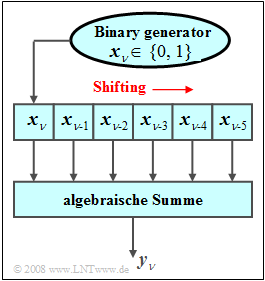Exercise 2.3: Algebraic Sum of Binary Numbers
A random number generator outputs a binary random number $x_\nu$ at each clock time $(\nu)$ , which can be $0$ or $1$ .
- The value "1" occurs with probability $p = 0.25$ .
- The individual values $x_\nu$ are statistically independent of each other.
The binary numbers are stored in a shift register withnbsp; $I = 6$ memory cells.
At each clock instant, the contents of this shift register are shifted one place to the right and the algebraic sum $y_\nu$ of the shift register contents is formed in each case:
- $$y_{\nu}=\sum\limits_{i=0}^{5}x_{\nu-i}=x_{\nu}+x_{\nu-1}+\ \text{...} \ +x_{\nu-5}.$$
Hints:
- The exercise belongs to the chapter binomial distribution.
- To check your results you can use the interactive applet Binomial and Poisson distribution .
Questions
Solution
- $$y_{\nu}\in\{0,1,\ \text{...} \ ,6\}\hspace{0.3cm}\Rightarrow\hspace{0.3cm} y_{\rm max} \hspace{0.15cm} \underline{= 6}.$$
(2) Es liegt eine Binomialverteilung vor. Daher gilt mit $p = 0.25$:
- $${\rm Pr}(y =0)=(1-p)^{\it I}=0.75^6=0.178,$$
- $${\rm Pr}(y=1)=\left({ I \atop {1}}\right)\cdot (1-p)^{I-1}\cdot p= \rm 6\cdot 0.75^5\cdot 0.25=0.356,$$
- $${\rm Pr}(y=2)=\left({ I \atop { 2}}\right)\cdot (1-p)^{I-2}\cdot p^{\rm 2}= \rm 15\cdot 0.75^4\cdot 0.25^2=0.297,$$
- $$\Rightarrow \hspace{0.3cm}{\rm Pr}(y>2)=1-{\rm Pr}(y=0)-{\rm Pr}( y=1)-{\rm Pr}( y=2)\hspace{0.15cm} \underline{=\rm 0.169}.$$
(3) Nach der allgemeinen Gleichung gilt für den Mittelwert der Binomialverteilung:
- $$m_y= I\cdot p\hspace{0.15cm} \underline{=\rm 1.5}.$$
(4) Entsprechend gilt für die Streuung der Binomialverteilung:
- $$\sigma_y=\sqrt{ I \cdot p \cdot( 1- p)} \hspace{0.15cm} \underline{= \rm 1.061}.$$
(5) Richtig ist der Lösungsvorschlag 2:
- Ist $y_\nu = 0$, so können zum nächsten Zeitpunkt nur die Werte $0$ und $1$ folgen, nicht aber $2$, ... , $6$.
- Das heißt: Die Folge $ \langle y_\nu \rangle$ weist (starke) statistische Bindungen auf.
(6) Die gesuchte Wahrscheinlichkeit ist identisch mit der Wahrscheinlichkeit dafür, dass das neue Binärsymbol gleich dem aus dem Schieberegister herausgefallenen Symbol ist. Daraus folgt:
- $${\rm Pr} (y_{\nu} = \mu\hspace{0.05cm}| \hspace{0.05cm} y_{\nu-{1}} = \mu) = {\rm Pr}(x_{\nu}= x_{\nu-6}). $$
- Da die Symbole $x_\nu$ statistisch voneinander unabhängig sind, kann hierfür auch geschrieben werden:
- $${\rm Pr}(x_{\nu} = x_{\nu-6}) = {\rm Pr}\big[(x_{\nu}= 1)\hspace{0.05cm}\cap\hspace{0.05cm}(x_{\nu-6}= 1)\hspace{0.05cm}\cup \hspace{0.05cm}(x_\nu=0)\hspace{0.05cm}\cap\hspace{0.05cm}(x_{\nu-6} =0)\big]= p^{2}+(1- p)^{2}=\rm 0.25^2 + 0.75^2\hspace{0.15cm} \underline{ = 0.625}. $$
